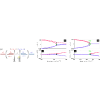Parametrically enhancing sensor sensitivity at an exceptional point
引用次数: 0
Abstract
We propose a scheme to enhance the sensitivity of non-Hermitian optomechanical mass sensors. The benchmark system consists of two coupled optomechanical systems where the mechanical resonators are mechanically coupled. The optical cavities are driven either by a blue-detuned or red-detuned laser to produce gain and loss, respectively. Moreover, the mechanical resonators are parametrically driven through the modulation of their spring constant. For a specific strength of the optical driving field and without parametric driving, the system features an exceptional point (EP). Any perturbation to the mechanical frequency (dissipation) induces a splitting (shifting) of the EP, which scales as the square root of the perturbation strength, resulting in a sensitivity-factor enhancement compared with conventional optomechanical sensors. The sensitivity enhancement induced by the shifting scenario is weak as compared to the one based on the splitting phenomenon. By switching on parametric driving, the sensitivity of both sensing schemes is greatly improved, yielding to a better performance of the sensor. We have also confirmed these results through an analysis of the output spectra and the transmissions of the optical cavities. In addition to enhancing EP sensitivity, our scheme also reveals nonlinear effects on sensing under splitting and shifting scenarios. This work sheds light on mechanisms of enhancing the sensitivity of non-Hermitian mass sensors, paving a way to improve sensors performance for better nanoparticles or pollutants detection and for water treatment.

在特殊点上参数化提高传感器灵敏度
我们提出了一种提高非ermitian 光电机械质量传感器灵敏度的方案。基准系统由两个耦合光机械系统组成,其中机械谐振器是机械耦合的。光腔由蓝色调谐或红色调谐激光器驱动,分别产生增益和损耗。此外,机械谐振器通过调制其弹簧常数进行参数驱动。对于特定强度的光驱动场,在没有参数驱动的情况下,系统会出现一个特殊点(EP)。对机械频率的任何扰动(耗散)都会引起 EP 的分裂(移动),其规模为扰动强度的平方根,从而使灵敏度系数比传统光机械传感器有所提高。与基于分裂现象的灵敏度增强相比,移位情况引起的灵敏度增强较弱。通过切换参数驱动,这两种传感方案的灵敏度都得到了极大提高,从而使传感器的性能更佳。我们还通过分析输出光谱和光腔的透射率证实了这些结果。除了提高 EP 灵敏度外,我们的方案还揭示了分光和移光情况下传感的非线性效应。这项工作揭示了提高非赫米提质量传感器灵敏度的机制,为提高传感器性能,更好地检测纳米粒子或污染物以及进行水处理铺平了道路。
本文章由计算机程序翻译,如有差异,请以英文原文为准。
求助全文
约1分钟内获得全文
求助全文

 求助内容:
求助内容: 应助结果提醒方式:
应助结果提醒方式:


